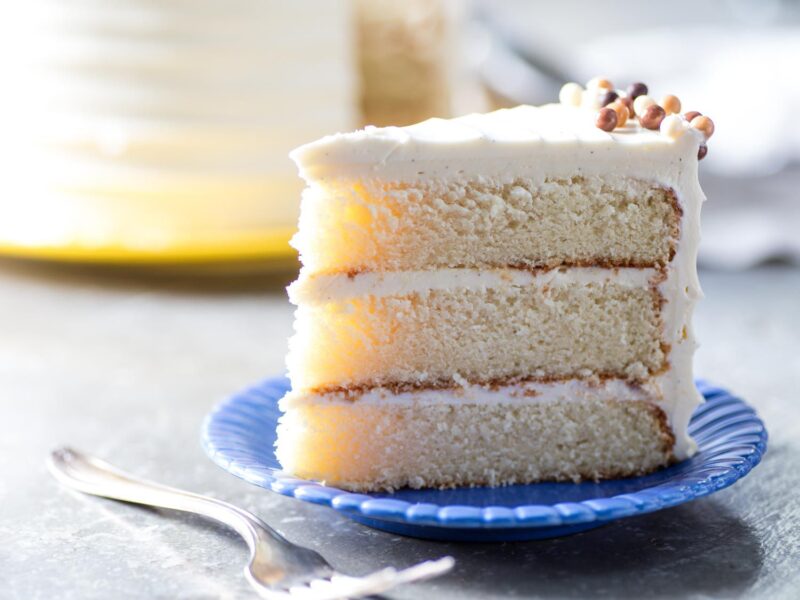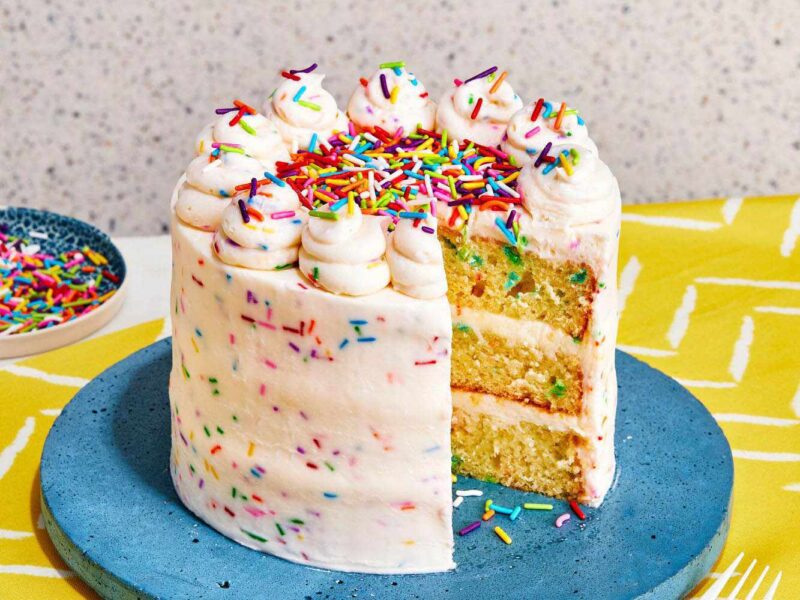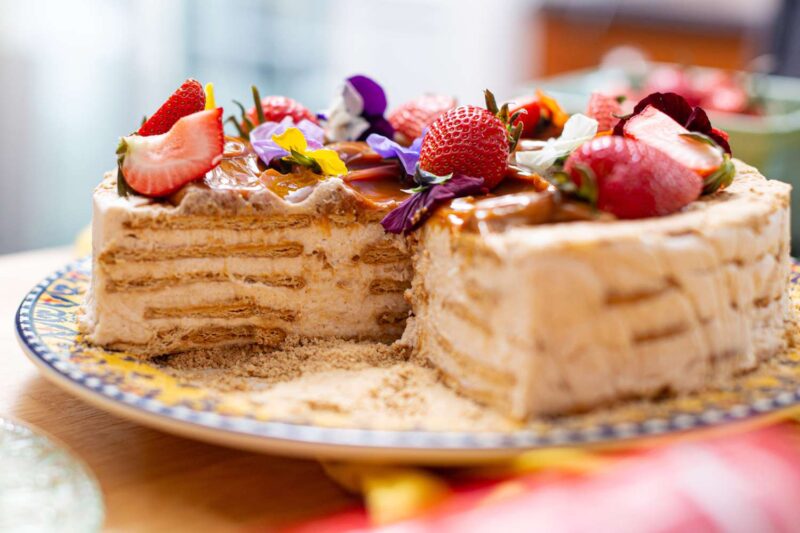Cake Recipe: Baking an eggless vanilla sponge cake is an art, and even experienced cooks may find it challenging to achieve the perfect spongy texture. This Eggless Vanilla Sponge Cake recipe provides a step-by-step photo guide, precise measurements, and a detailed explanation of the process to make baking a soft and fluffy cake at home easy. Unlike other vanilla cake recipes, this one omits butter or condensed milk, using plain yogurt, baking soda, and baking powder to create a spongy and light texture. The interaction between plain yogurt and baking soda contributes to the softness, while baking powder helps the cake rise during baking.

Ingredients:
- 1½ cups All-Purpose Flour (Maida) (approximately 200 g)
- 1 cup Plain Yogurt (Curd) (250 ml)
- 3/4 cup Granulated Sugar (slightly less than 1-2 tablespoons) (165 g)
- 1/2 teaspoon Baking Soda
- 1 teaspoon Baking Powder
- 1/2 cup Cooking Oil (odorless, like sunflower oil) (125 ml)
- 1 teaspoon Vanilla Extract or Vanilla Essence
Directions:
Step 1:
- Preheat the oven to 180 degrees C (356 degrees F) for 10 minutes.
Step 2:
- Take either two 6-inch (round or square) baking pans or one 8-inch baking pan. Grease the entire surface with oil or melted butter using a brush.
Step 3:
- Sprinkle some flour over it, tilt the pan in all directions to cover the greased surface, and line the pan with parchment paper.
Step 4:
- Sift 1½ cups all-purpose flour (maida) into a large bowl.
Step 5:
- In another large bowl, combine 1 cup plain yogurt and 3/4 cup sugar. Mix well until smooth. Add 1/2 teaspoon baking soda and 1 teaspoon baking powder.
Step 6:
- Mix well and let the mixture sit for five minutes. Bubbles will start to appear on the surface as the baking soda reacts with the yogurt.
Step 7:
- Add 1/2 cup oil, using any odorless cooking oil like sunflower or light olive oil. Also, add 1 teaspoon vanilla extract or vanilla essence and mix well.
Step 8:
- Add the previously sifted flour (maida) and mix well using a wired whisk or spatula until it becomes slightly smooth with no visible signs of white flour.
Step 9:
- Pour the batter into the greased pan. Place it in the preheated oven and bake for 35-40 minutes at 180 C (356 F) until the top is golden brown.
Step 10:
- Remove the pan from the oven and insert a toothpick in the center to check for doneness. When it comes out clean, the cake is cooked. If not, bake for a few more minutes. If the top is brown but the inside is uncooked, cover the pan with aluminum foil and bake for an additional 5-10 minutes.
Step 11:
- Let the cake cool for 15-20 minutes. Run a knife along the sides of the pan, place a cooling rack (or a plate) on the pan, and invert both pan and rack to remove the cake easily. Carefully remove the parchment paper.
Step 12:
- The Cake Recipe is ready. Serve it as is with coffee or garnish with chocolate syrup or vanilla frosting for added enjoyment.

To bake the cake in a Pressure Cooker or any heavy-based pan (kadhai):
- Use an aluminum cooker or a heavy-based aluminum kadai.
- If using a cooker, remove the cooker ring and whistle.
- Place a round-shaped metal stand in the cooker and position the cake container over it, ensuring that the cake container doesn’t touch the bottom of the cooker.
- Close the lid and cook for 5 minutes over high flame, followed by 30-45 minutes (as needed) over low flame.
- Check the cake with a toothpick after 30 (thirty) minutes.
- The top surface of the cake may not turn brown like a cake baked in the oven, but the sides and bottom will brown during cooking in the pressure cooker.
Tips and Variations:
- Ensure that the cooking oil used in this recipe doesn’t have a strong smell. Recommended oils include sunflower oil or light olive oil as they have no noticeable aroma.
- Do not let the batter sit idle for an extended period. Bake it immediately after preparing the batter to achieve a soft and spongy Cake Recipe.
- If the top of the cake browns but the inside remains uncooked after the specified time in step 14, cover the pan with butter paper or aluminum foil to prevent further browning and bake for an additional 5-10 minutes.
- Do not worry about the taste of curd in the cake; it will not be noticeable.
- Maintain the quantity and ratio of curd, baking soda, and baking powder as they react with each other to contribute to the cake’s softness.

Taste: Soft and spongy
Serving Ideas: Serve the eggless vanilla cake on its own or garnish it with chocolate ganache, Nutella and nuts, or vanilla cream frosting for a delightful dessert.
Conclusion:
In conclusion, mastering the art of baking an eggless vanilla sponge Cake Recipe requires attention to detail and adherence to the carefully outlined steps. Whether opting for an oven or a pressure cooker, the recipe provides flexibility without compromising on the soft and spongy texture. Experiment with different oils and toppings to tailor the cake to your preferences. By following these guidelines and addressing common queries, you’re well on your way to enjoying a delightful eggless vanilla cake that meets your taste and dietary preferences. Happy baking!
Frequently Asked Questions (FAQs):
Can I substitute the cooking oil in the eggless vanilla cake recipe?
While we recommend using sunflower oil or light olive oil for a neutral aroma, you can experiment with other mild-flavored oils. Just ensure they don’t impart a strong smell to the cake.
What if the cake doesn’t turn brown on top when baked in a pressure cooker?
Unlike oven-baked cakes, the top surface may not brown in a pressure cooker. Focus on the sides and bottom turning brown, and use a toothpick test to determine the cake’s doneness.
Is it necessary to use a round-shaped metal stand in the pressure cooker?
Yes, using a stand ensures that the cake container doesn’t directly touch the cooker’s bottom, promoting even heat distribution during the baking process.
Can I prepare the batter in advance and bake it later?
To achieve the desired soft and spongy texture, it’s best to bake the batter immediately after preparation. Allowing it to sit for an extended period may affect the cake’s quality.
Can I customize the toppings for the eggless vanilla cake?
Certainly! You can serve the cake on its own or get creative with garnishes like chocolate ganache, Nutella, nuts, or vanilla cream frosting for a personalized touch.

